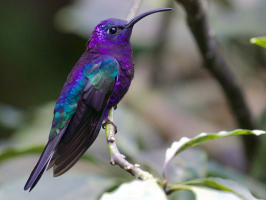Top 10 World's Most Beautiful Blue Animals
Blue is the most popular color in the world. However, blue is one of the rarest occurring pigments found in nature. The existence of blue creatures is far less ... read more...common compared to the prevalence of green, yellow, and red species. Any instances of blue coloration in animals are typically the result of structural effects, such as iridescence and selective reflection. Below are the most beautiful blue animals in the world, let's find out!
-
Spix's Macaw (Cyanopsitta spixii), also known as the little blue macaw, is a macaw species that was endemic to Brazil. It is a member of the tribe Arini in the subfamily Arinae (Neotropical parrots), part of the family Psittacidae (the true parrots). The IUCN formally declared this bird extinct in the wild in 2019 after a multi-year assessment found that it had totally vanished from its natural range. It is a medium-sized parrot that weighs about 300 grams, making it lighter than the majority of huge macaws. It has a grey-blue head, light blue underparts, and vibrant blue upper parts, giving it a multi-hued look.
The species lived in riparian Caraibeira (Tabebuia aurea) woodland galleries in the Rio So Francisco drainage basin in interior northeastern Brazil's Caatinga dry forest environment. Due to its reliant nature on the tree for roosting, foraging, and nesting, its natural habitat was quite constrained. It mostly consumes the seeds and nuts of Caraiba and different Euphorbiaceae (spurge) bushes, which make up the majority of Caatinga's vegetation. The bird was rare in the wild for much of the twentieth century because of deforestation in its small range and specialized habitat. It has always been quite uncommon in captivity, in part because of how far away its natural area is.

Science 
American Bird Conservancy -
Glaucus Atlanticus (common names include the blue sea dragon, sea swallow, blue angel, blue glaucus, dragon slug, blue dragon, blue sea slug, and blue ocean slug) is a species of small, blue sea slug, a pelagic (open-ocean) aeolid nudibranch, a shell-less gastropod mollusk in the family Glaucidae. These pelagic sea slugs use the water's surface tension to stay upright while they float upside down, where the wind and ocean currents carry them along. In order to blend in with the blue of the water, G. atlanticus uses countershading, turning the blue side of its body upward. When viewed from above underwater, the silver/gray side of the sea slugs blends in with the sunshine bouncing off the water's surface.
Glaucus atlanticus feed on other pelagic creatures, including the Portuguese man o' war and other venomous siphonophores. This sea slug stores stinging nematocysts from the siphonophores within its own tissues as defense against predators. Humans handling the slug may receive a very painful and potentially dangerous sting.

Wikipedia 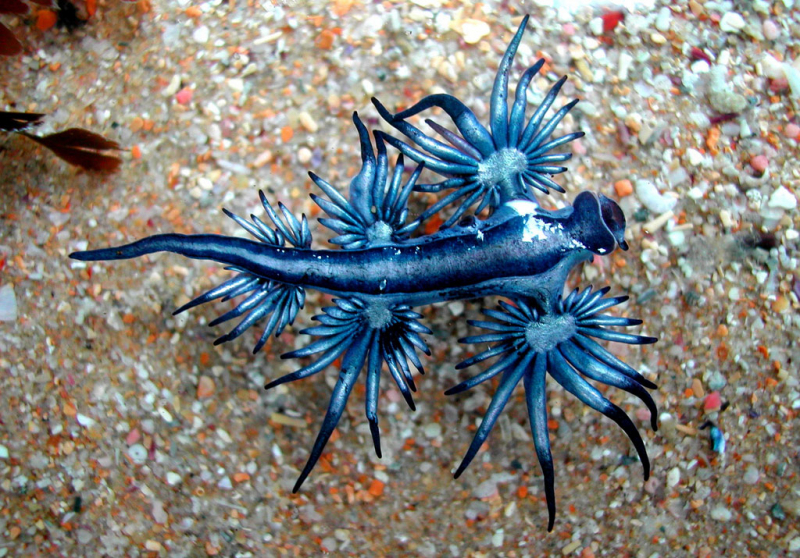
DKN News -
The Blue Poison Dart Frog or blue poison arrow frog (Dendrobates tinctorius "azureus") is a poison dart frog found in the forests surrounded by the Sipaliwini Savanna, which is located in southern Suriname (known in Surinamese Dutch as blauwe pijlgifkikker) and adjacent far northern Brazil. D. tinctorius azureus is also known by its indigenous Tirio name, okopipi. Its scientific name comes from its azure (blue) color. While frequently considered a valid species in the past, recent authorities treat it as a variant of D. tinctorius.
D. tinctorius "Azureus" is a medium-sized frog that weighs about 8 g and grows to 3.0-4.5 cm in length. Males have larger toes, but females are bigger and roughly half a centimeter longer. In the wild, the frog typically lives five to seven years. It serves as a warning to predators with its vivid blue skin, which is often darker around its limbs and tummy. A defense mechanism against possible predators was found in the glands of toxic alkaloids. These toxins immobilize and occasionally kill the prey. Each frog has a distinct pattern of black dots that allow for identification. The posture of this frog species is characterized by its hunchback. Each foot has four toes, which each have a flattened tip with a suction cup pad used for gripping. The tips of the toes in females are round, while males have heart-shaped tips.

Sciencing 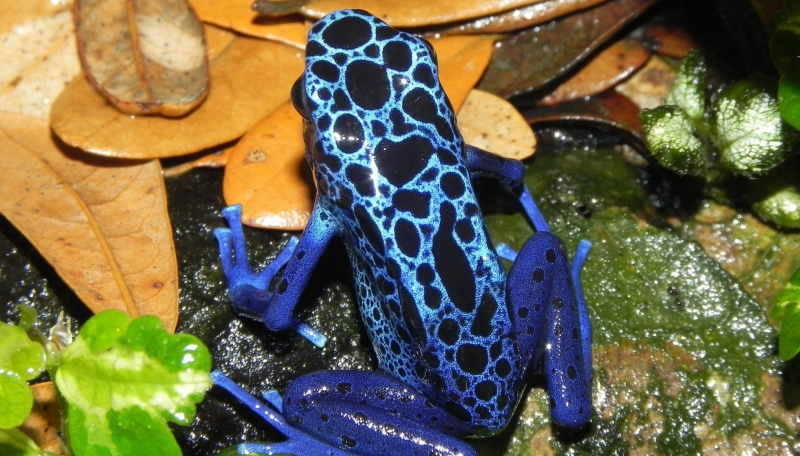
Kidadl -
The blue iguana (Cyclura lewisi), also known as the Grand Cayman ground iguana, Grand Cayman Blue Iguana, or Cayman Island rock iguana, is an endangered species of lizard that is endemic to the island of Grand Cayman. It was previously thought to be a subspecies of the Cuban iguana, Cyclura nubila, but Frederic J. Burton reclassified it as a separate species in a 2004 article because, in his opinion, the genetic variations discovered between the various C. nubila populations four years earlier justified this interpretation. One of the lizard species that can live the longest is the blue iguana (possibly up to 69 years).
Because female blue iguanas must dig holes in the sand to lay eggs in the months of June and July, their preferred habitat is rocky, sunny, open regions in dry woods or close to the sea. September sees the possible laying of a second clutch. Plants, fruits, and flowers are all parts of the herbivorous diet of the blue iguana. Its brown to gray tint has a bluish cast that is particularly noticeable in the breeding season and on males. It is huge and heavy-bodied, with a dorsal crest of short spines extending from the neck's base to the tail's tip.

iStock 
Wild View - Wildlife Conservation Society -
The Blue Morpho butterfly is one of the largest butterflies in the world with a wingspan of 5-6 inches. They are primarily found in South and Central American tropical woods. The distinctive feature of blue morpho butterflies is their bright blue wings with black borders. Male morpho butterfly wings are more lovely and colorful than those of females. Blue morpho's wings have brown undersides with numerous eyespots. The blue morpho's back wings also aid in camouflage, allowing them to conceal themselves from potential predators such as lizards, frogs, and birds.
Most of the time, blue morpho butterflies were seen in the lower bushes of tropical woods. However, during mating season, they become clearly visible to all areas of the forest. Beautiful butterflies also release strong smells from their glands when they are threatened by other animals. They mainly feed on leaves of varieties of plants, fungi, and rotting fruits.

Earth.com 
Wikimedia Commons -
The Mandarinfish (Synchiropus splendidus), sometimes known as a mandarin dragonet, is a small, vividly colored member of the family of dragonets that is well-liked in the saltwater aquarium industry. The native range of the mandarin fish is in the Pacific, roughly from the Ryukyu Islands south to Australia. It frequently inhabits some of the warmer seas. The mandarin fish consumes a variety of foods, including fish eggs, ostracods, tiny gastropods, grammarian amphipods, and harpacticoid copepods. The fish selectively peck at small food trapped on the coral substrate in a home range of many square meters while feeding continuously throughout the day in the wild.
The only physical similarity between a goby and a mandarin fish is in their body shapes. The striking coloring features a swirling orange stripe on the face and a brilliant blue background with bold blue stripes. Large pelvic fins are often mistaken for pectoral fins because they are utilized for "walking" on the ocean floor. The actual pectorals are practically in the middle and are almost completely transparent, with the exception of the anal fins and a portion of the tail, which are brightly striped in orange and blue. Males have very tall dorsal fins with eye-catching orange and blue patterns. Typically, the eyes are crimson with black pupils.
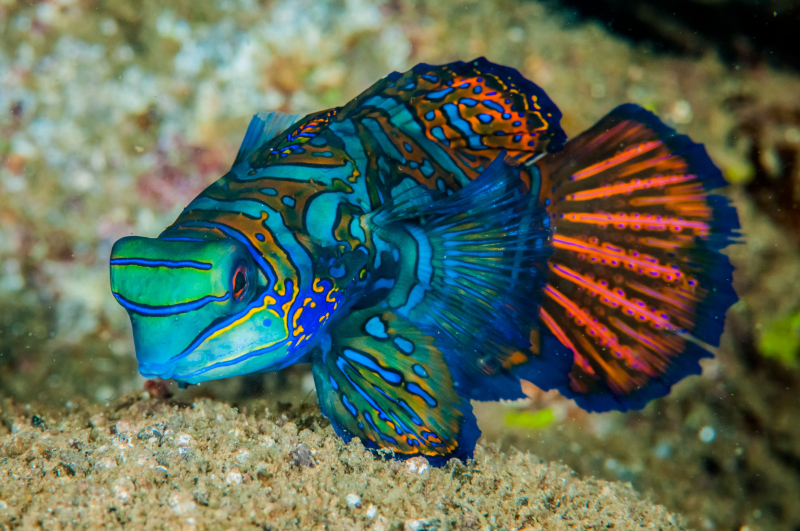
The Spruce Pets 
Fish Informer -
Nosy Be Panther Chameleon is a very popular panther chameleon. It is the 3rd most common subspecies of panther chameleon partly as it has some exceptional colors including blues, turquoise, purples, and greens. These stunning Nosy be panther chameleons live on the little island of Nosy Be, which is located off the northwest coast of Madagascar. These Chameleons are is easily the most gorgeous colors and easiest to handle of all species of pet chameleon.
The average length of a male nosy be panther chameleon is up to 18 inches, whilst the average length of a female is 10 to 14 inches. A healthy male panther chameleon weighs anywhere between 140 and 180 grams, whereas a healthy female weighs anything between 60 and 100 grams. Nosy Be Panther Chameleons readily intake almost any feeder insect. Some common feeder insects include crickets, walking stick bugs, roaches, flies, and different types of warms.
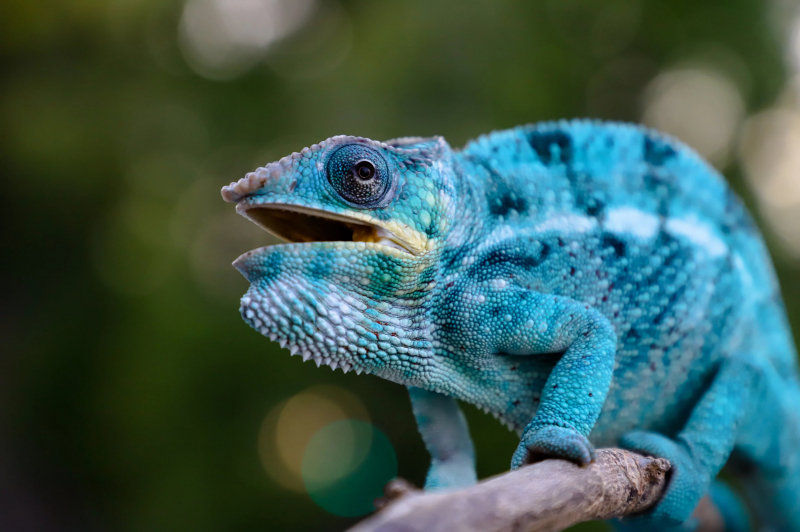
iStock 
Madcham -
A type of marine angelfish is called the Emperor Angelfish (Pomacanthus imperator). It is a fish that lives near reefs and is found in the Red Sea, the Indian and Pacific Oceans, Hawaii, and the Austral Islands. This species typically has steady numbers and is not endangered in any significant ways. Because of its distinctive, vivid pattern of colors, it is a favorite among photographers, artists, and aquarists.
The emperor angelfish exhibits a clear distinction between its juvenile and adult forms. The bodies of the juveniles are dark blue with concentric curving lines that alternate between pale blue and white, the smallest of which are placed posteriorly and are totally encased within one another. At the front, these lines are vertical. The caudal fin is transparent, whereas the dorsal fin has a white edge around it. The adults have a light blue face with a dark blue mask covering the eyes, horizontal blue and yellow stripes, and a yellow caudal fin. Above the pectoral fins, there is a blackish band, the top of which is above the level of the upper orbit. The front margin of this band is bright blue and the rear margin is a thin yellow line. The anal fin has a dark blue background with light blue horizontal stripes.
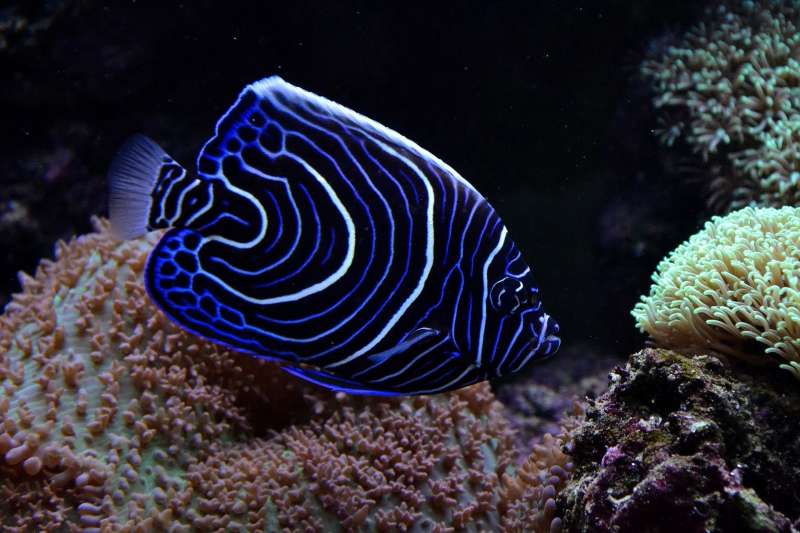
Snorkeling Thailand 
Pinterest -
The Blue Jay (Cyanocitta cristata) is a passerine bird in the family Corvidae, native to eastern North America. It lives in most of the eastern and central United States; some eastern populations may be migratory. Resident populations are also in Newfoundland, Canada; breeding populations are found across southern Canada. It is widespread in residential areas and breeds in both coniferous and deciduous woodlands. It features a crest that is primarily blue with white underparts and a blue-collar around its neck. There is also a black border around the crest. Males and females are roughly the same size and have year-round uniformity in their plumage. There are now four recognized subspecies.
The blue jay primarily eats soft fruits, seeds, nuts, including acorns, which it may bury to consume later, arthropods, and sporadically small vertebrates. It normally forages for food on the ground, in bushes and trees, and occasionally it hawks insects out of the air. Other birds have been beheaded by blue jays, who occasionally raid nests and are quite violent towards them. Both sexes take part in the construction of an open cup nest in a tree's limbs. The eggs, which are blue or light brown with darker brown markings, can range in number from two to seven in the clutch. The female cares for the altricial young for 8 to 12 days after they hatch. They might spend one to two months with their parents.

Wikipedia 
eBird -
Regal Tang (Paracanthurus hepatus) is a species of Indo-Pacific surgeonfish. A popular fish in marine aquaria, it is the only member of the genus Paracanthurus. The Indo-Pacific is home to the Regal Tang. The Great Barrier Reef of Australia, the Philippines, Indonesia, Japan, New Caledonia, Samoa, East Africa, and Sri Lanka all have them as do the reefs. One of the most prevalent and well-liked marine aquarium fish in the world is the regal tang. They reside in pairs or compact communities of eight to fourteen people. On the seaweed side of coral reefs, you can also find them next to cauliflower corals.
They feature a black "palette" pattern, a yellow tail, and a royal blue body. In the western and central Indian Ocean, the bottom body is yellow. It expands to 30 cm (12 inches). Males are typically larger than females and weigh about 600 g (21 oz) on average as adults. This fish has a circular body shape, a pointed, pancake-like nose, thin scales, and a flat, pancake-like appearance. The regal tang has three anal spines, 24–26 anal soft yellow rays, 26–28 dorsal soft rays, and nine dorsal spines.

Wikipedia 
Live Science




























